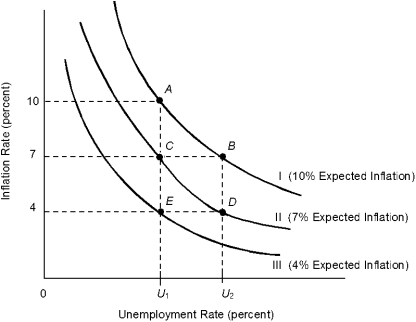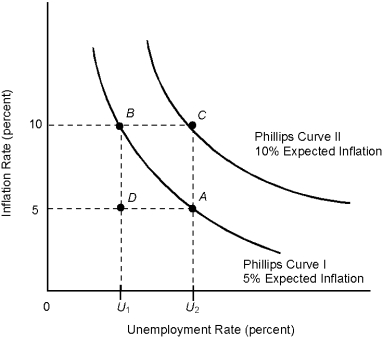A) supply curve to the left and increases real GDP.
B) demand curve to the left and increases real GDP.
C) demand curve to the right and decreases real GDP.
D) supply curve to the right and increases real GDP.
E) supply curve to the left and reduces real GDP.
Correct Answer

verified
Correct Answer
verified
True/False
In rational expectations theory, an expected increase in the money supply is represented by an upward movement along the vertical Phillips curve.
Correct Answer

verified
Correct Answer
verified
Multiple Choice
Along the short-run Phillips curve, the
A) actual inflation rate is equal to the expected inflation rate.
B) expected inflation rate is constant.
C) observed unemployment rate is equal to the natural rate of unemployment.
D) real wage rate is zero.
E) nominal wage rate is constant.
Correct Answer

verified
Correct Answer
verified
Multiple Choice
Total factor productivity is the ratio of
A) skilled labor to unskilled labor.
B) wartime productivity to peacetime productivity.
C) manufacturing productivity to service productivity.
D) agricultural productivity to industrial productivity.
E) the economy's output to its stock of capital and labor.
Correct Answer

verified
Correct Answer
verified
True/False
If the growth rate of resources is zero and real output is growing at 4 percent, then total factor productivity has risen by 4 percent.
Correct Answer

verified
Correct Answer
verified
Multiple Choice
According to the adaptive expectations view, the Phillips curve is
A) vertical in both the short run and the long run.
B) downward sloping in the short run and vertical in the long run.
C) downward sloping in both the short run and the long run.
D) horizontal in both the short run and the long run.
E) vertical in the short run and downward sloping in the long run.
Correct Answer

verified
Correct Answer
verified
Multiple Choice
Which of the following statements is not consistent with the theory of rational expectations?
A) The Phillips curve is vertical.
B) Expansionary fiscal policy that is anticipated is ineffective even in the short run.
C) The aggregate supply curve is vertical.
D) People adjust slowly to changes in the inflation rate.
E) A downward-sloping Phillips curve does not exist for expected changes.
Correct Answer

verified
Correct Answer
verified
Multiple Choice
The slope of the short-run Phillips curve is consistent with the
A) long-run tradeoff between the unemployment rate and inflation.
B) long-run tradeoff between inflation and GDP.
C) short-run tradeoff between the money supply and interest rates.
D) short-run tradeoff between business productivity and wage contracts.
E) short-run tradeoff between the unemployment rate and inflation.
Correct Answer

verified
Correct Answer
verified
Multiple Choice
U.S. economic data from 1955 to 2009 give evidence of
A) a positive relationship between the unemployment rate and inflation.
B) a negative relationship between the unemployment rate and inflation.
C) a constant rate of unemployment with changing rates of inflation.
D) a constant rate of inflation with changing rates of unemployment.
E) no particular relationship between the unemployment rate and inflation.
Correct Answer

verified
Correct Answer
verified
True/False
The tradeoff between inflation and the unemployment rate comes from expected inflation.
Correct Answer

verified
Correct Answer
verified
Multiple Choice
Suppose that the economy grows by 4 percent, total factor productivity grows by 3 percent, and the labor force increases by 6 percent. If labor and capital are the only inputs and labor contributes 40 percent to GDP, then the stock of capital must have
A) fallen by 5 percent.
B) fallen by 3 percent.
C) fallen by 2 1/3 percent.
D) risen by 3 percent.
E) risen by 7 percent.
Correct Answer

verified
Correct Answer
verified
Multiple Choice
Figure 16.3
 -In Figure 16.3, movement from point C to point D corresponds to a
-In Figure 16.3, movement from point C to point D corresponds to a
A) rightward shift of the aggregate demand curve.
B) rightward shift of the aggregate supply curve.
C) movement down the long-run aggregate supply curve.
D) leftward shift of the aggregate supply curve.
E) leftward shift of the aggregate demand curve.
Correct Answer

verified
Correct Answer
verified
True/False
An increase in the long-run aggregate supply curve reflects economic growth.
Correct Answer

verified
Correct Answer
verified
Multiple Choice
Figure 16.2
 -Refer to Figure 16.2. Movement from point A to point B could be the result of a(n)
-Refer to Figure 16.2. Movement from point A to point B could be the result of a(n)
A) increase in the money supply.
B) decrease in government spending.
C) decrease in the money supply.
D) increase in tax rates.
E) economic recession.
Correct Answer

verified
Correct Answer
verified
True/False
Suppose that the economy grows by 3 percent, total factor productivity grows by 2 percent, and the labor force grows by 2 percent. If labor contributes 40 percent to real GDP, then the stock of capital must have risen by 0.33 percent.
Correct Answer

verified
Correct Answer
verified
Multiple Choice
Long-term economic growth requires a permanent
A) decline in the average price level.
B) leftward shift of the vertical Phillips curve.
C) rise in the natural rate of unemployment.
D) rightward shift of the aggregate demand curve.
E) rightward shift of the vertical aggregate supply curve.
Correct Answer

verified
Correct Answer
verified
Multiple Choice
If the short-run Phillips curve shifts to the right, we can conclude that
A) the tradeoff between inflation and unemployment worsens over time.
B) the tradeoff between inflation and unemployment improves over time.
C) higher inflation rates are associated with any given level of unemployment.
D) the tradeoff between inflation and unemployment remains unchanged.
E) the unemployment rate rises for any given inflation rate.
Correct Answer

verified
Correct Answer
verified
Multiple Choice
Suppose that the economy grows by 3 percent, the labor force rises by 2 percent, and capital rises by 1 percent. If capital takes 40 percent of real GDP and labor takes 60 percent of real GDP, then the growth in total factor productivity must be
A) 14 percent.
B) 1.4 percent.
C) 0.6 percent.
D) 6 percent.
E) 10 percent.
Correct Answer

verified
Correct Answer
verified
True/False
According to the Phillips curve, the cost of reducing inflation is a higher unemployment rate.
Correct Answer

verified
Correct Answer
verified
Multiple Choice
Suppose that the economy grows by 6 percent, total factor productivity grows by 4 percent, and the capital stock increases by 2 percent. If labor and capital are the only inputs and capital contributes 25 percent to GDP, then the labor force has risen by
A) 1.5 percent.
B) 2 percent.
C) 4 percent.
D) 6 percent.
E) 8 percent.
Correct Answer

verified
Correct Answer
verified
Showing 61 - 80 of 135
Related Exams